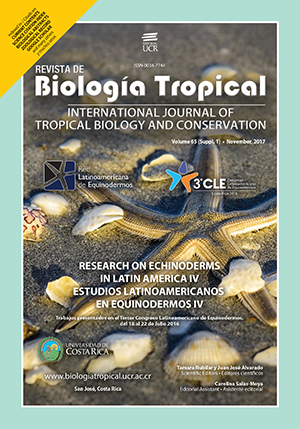Abstract
The starfish Phataria unifascialis is widely distributed in the eastern cost of the Pacific Ocean, found on rocky bottoms, at depths between 0 and 50 m. The original description of P. unifascialis made by Gray in 1840 was brief and inaccurate in some important aspects, such as distribution area, plate arrangement and ambulacral spines. Here, we improve the description of P. unifascialis with SEM images and description of its mesodermal skeleton on the basis of a large sample. Rev. Biol. Trop. 65(Suppl. 1): S258-S271. Epub 2017 November 01.
References
Alvarado, J. J., & Solís-Marín, F. A. (2013). Echinoderm research and diversity in Latin America (pp. 1-9). Springer Berlin Heidelberg.
Gray, J. E. (1840). A synopsis of the genera and species of the class Hypostoma (Asterias Linnaeus). Annals and Magazine of Natural History 6: 175-184 and 275-290.
Morgan, M. B., & Cowles, D. L. (1997). The effects of temperature on the behaviour and physiology of Phataria unifascialis (Gray) (Echinodermata, Asteroidea) Implications for the species’ distribution in the Gulf of California, Mexico. Journal of experimental marine biology and ecology, 208(1-2), 13-27.
Mortensen, T., & Mortensen, T. (1921). Studies of the development and larval forms of echinoderms. Gad.
Pérez-Ruzafa, A., Alvarado, J. J., Solís-Marín, F. A., Hernández, J. C., Morata, A., Marcos, C., ... & Barraza, E. (2013). Latin America echinoderm biodiversity and biogeography: Patterns and affinities. In Echinoderm research and diversity in Latin America (pp. 511-542). Springer Berlin Heidelberg.
Thuy, B., & Stöhr, S. (2016). A new morphological phylogeny of the Ophiuroidea (Echinodermata) accords with molecular evidence and renders microfossils accessible for cladistics. PloS one, 11(5), e0156140.
Turner, R. L., & Dearborn, J. H. (1972). Skeletal morphology of the mud star, Ctenodiscus crispatus (Echinodermata: Asteroidea). Journal of Morphology, 138(2), 239-262.
Sladen, W. P. (1889). Asteroidea. Report on the Asteroidea collected during the voyage of HMS ‘Challenger’during the years 1873Á76. Report on the Scientific Results of the Voyage of HMS Challenger. Zoology, 30.
Ziesenhenne, F. C. (1937). The Templeton Crocker Expedition. X. Echinoderms from the west coast of Lower California, the Gulf of California and Clarion Island. Zoologica, NY, 22, 209-239.
##plugins.facebook.comentarios##

This work is licensed under a Creative Commons Attribution 4.0 International License.
Copyright (c) 2017 Revista de Biología Tropical






